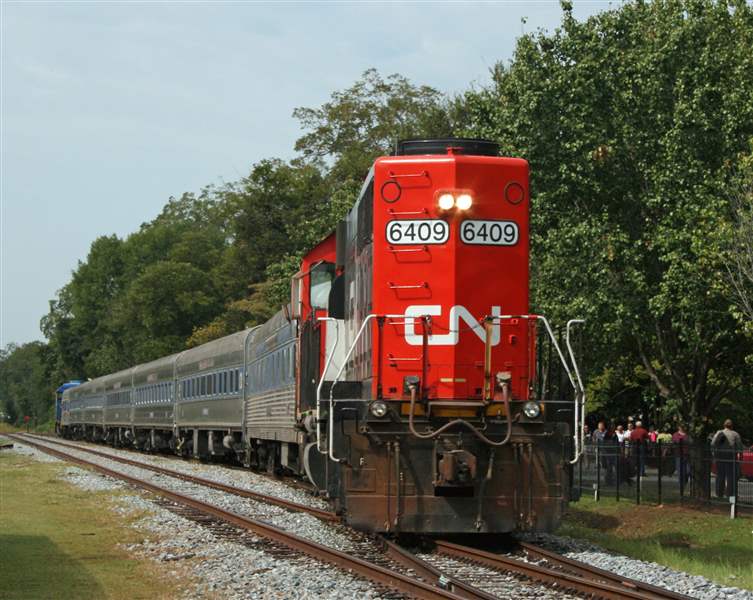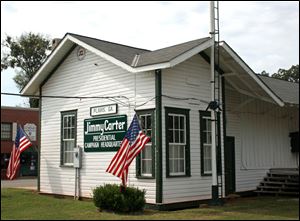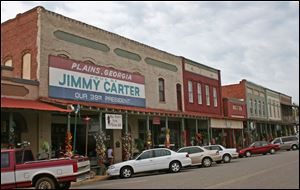
Georgia rail excursion is built around Carter sites
11/25/2012
The SAM Shortline train pulls into Plains, Ga.
MIAMI HERALD

The SAM Shortline train pulls into Plains, Ga.
PLAINS, Ga. — The view from the train tells the story of this part of rural southwest Georgia: cotton fields speckled with puffs of white, peanut and soybean fields, groves of towering pecan trees. Rusted old cars that appear to have been parked in the same spot for decades. Gullies filled so thickly with kudzu that it ripples and flows like a river’s eddies and currents.
Then we roll into Plains, population 683, which looks frozen in the time of Jimmy Carter’s presidency. The historic train depot, closed in 1951, was Carter’s campaign headquarters in 1976 and now is a museum that focuses on that campaign. A big sign painted above a storefront in the tiny downtown shouts that this is the home of the 39th president of the United States. Jimmy and Rosalynn Carter still live here in the same house that they have owned since 1961.
I’m riding a SAM Shortline excursion train on a day trip that starts at Lake Blackshear on the western edge of Cordele, Ga., southwest of Macon, and runs west about 50 miles, then returns. This 6½-hour excursion goes to Plains, where we spend nearly two hours exploring the town, then Archery, the boyhood home of Carter and now a site managed by the National Park Service. On other days, the train has different itineraries along the same track.
The track dates to the Savannah, Americus, and Montgomery line of the late 1800s, which is where the SAM Shortline Excursion Train got its name. Cordele and Plains are among the towns that sprang up along the rail line when it was new.
The track had been in decline and was in danger of abandonment when the state bought it in 1999. The state parks division runs the excursions along with the Heart of Georgia Railroad — a private company that owns the engines — and the Southwest Georgia Railroad Excursion Authority, a state agency.
The locomotives are modified EMD GP-9s, diesel-electric locomotives built by General Motors in the 1950s and early 1960s. Most of the passenger cars date to the late 1940s and the Norfolk and Western and Pennsylvania Railroad and were later used as commuter trains by the Maryland Area Rapid Commuter Agency. One of the most historic pieces of equipment is the “Samuel H. Hawkins,” a 1939 tavern-observation car that was named for the founder and president of the Savannah, Americus, and Montgomery line.
We board the train at the Georgia Veterans State Park. The train is run by two Heart of Georgia Railroad engineer/conductors, but most of the people who welcome us aboard and answer questions during the ride are volunteers.
The train crosses the bridge over Lake Blackshear. Clusters of caladiums grow along the water line and cypress trees grow in the water. It is the end of September, and the first bits of fall color are just beginning to peek through the green of the oaks and maples. We pass stands of evergreens, fields of goldenrod, bales of picked cotton waiting to be picked up.
A stretch of track runs past ramshackle houses, where junk is strewn across the ground and old cars are slowly falling apart, past small industrial areas, and gracious homes in Americus.
Today’s excursion is built around the Jimmy Carter National Historic Site, which stretches from Plains about three miles west to Archery, and includes the train depot; the former Plains High School, which is now a museum and visitors center, and the farm in Archery, where the future president grew up.
We get off the train on Main Street in Plains, where there are an antique mall and shops selling peanut products and Jimmy Carter souvenirs; the gas station that was owned by Billy Carter, the president’s late brother; peanut warehouses, and the old train depot-turned-museum.
A few blocks to the east is the Plains High School museum. A few blocks west is the compound where the former president and first lady live. A little further away is Maranatha Baptist Church, where Jimmy Carter still teaches Sunday School most weeks — his Sunday School schedule is posted all over town and the Internet.
Most of the passengers head for Main Street to get lunch and a taste of peanut butter ice cream, but I go in the opposite direction. I want to see the Carter compound.
The first evidence that I’ve arrived is a sign half-hidden by trees that says “NO STOPPING. KEEP MOVING.” A rail fence keeps people on the sidewalk, except for a spot where the fencing detours and visitors can walk 20 or 25 feet onto the property, where signs tell about the 12-acre compound. Literature says the Carter home is a modest ranch house, but I can’t see it through the trees and the chain-link fences with privacy slats. A small Secret Service gatehouse at the head of the driveway ensures that tourists don’t wander up to the Carters’ door.
Our next stop is Archery, a town so tiny you won’t find it on a map. Earl and Lillian Carter moved here in 1928, when Jimmy was 4 years old, and the future president lived here until he left for college. Running water and power were not available until 1938, and the property has been restored to that pre-electricity era.
We walk through the house where Earl and Lillian raised their four children, past the clay tennis court that Earl Carter built, and into the country store where a young Jimmy worked. We look in through the windows of a shed where a blacksmith demonstrates his trade. We wander through the barn, past patches of cotton and sugar cane and a windmill, and look over a neat row of rusted farm equipment. In the fields beyond, a shaggy goat keeps company with horses.
The primary crop on the Carter farm was cotton, but when Earl Carter began growing peanuts, Jimmy sold them on the street. He took over the family peanut business after his father died in 1953.
We’re scheduled for a 50-minute stop in Archery, but after about half an hour, I feel a few drops of rain, and within a minute, it’s pouring. I run for the train, as do the other riders. Back on board, the fellow on the PA system says, “In Georgia we’ve got two kinds of rain — no rain and buckets of rain.”
We ride back in the rain, a gray sky looming over the fields, and I think that the fields must look the same as they did more than 60 years ago, when the rail cars we’re riding in were new.
If you go:
SAM Shortline excursion train: 877-GA-RAILS, http://samshortline.com
Jimmy Carter National Historic Site: 229-824-4104, www.nps.gov/jica

The SAM Shortline train pulls into Plains, Ga.

The former train depot in Plains, Ga., was Jimmy Carter's presidential campaign headquarters in 1976 and now is a museum.

Storefronts along the main commercial street in Plains announce that the town is the home of Jimmy Carter.